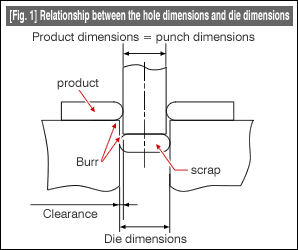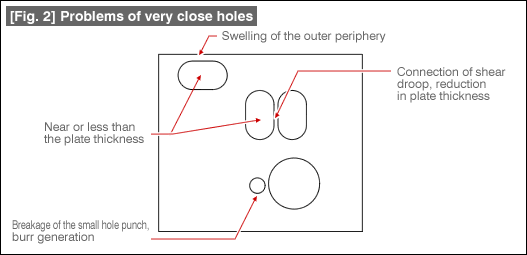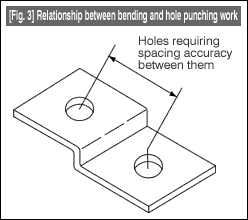#012 Basics of Blanking Work (2) Hole Punching Work
Hole punching is another type of basic blanking work. It is good to know the setting of conditions and the problems when carrying out this work.
| Although hole punching is the same as blanking work, the settings of the conditions of the die are different. The details of this are shown in Fig. 1. The punch dimensions are made equal to the dimensions of the hole to be punched. Further, a clearance is given in the die. This is the opposite of the settings in the blanking operation. The product remains above the die. The scrap passes through the die and falls down. In general, in order to make sure that the product does not warp due to hole punching, very often the die is made with a movable stopper structure. This is done in order to allow the material pressing member to move. |  |
Care should be taken during the hole punching operation when the condition is as shown in Fig. 2. This is because the problem shown in Fig. 2 can occur. When there is some effect on the product such as deformations, etc., it is necessary to take precautions in order to avoid these. It is desirable that the problems shown here are avoided by taking countermeasures with the dies.

| If the accuracy of the relationship is necessary in the position with a bend in between as is shown in Fig. 3, if the work is done before bending, the dimensions will vary causing problems. The process is designed so that the sequence is "Blanking → Bending → Hole punching" thereby eliminating the cause of variations. |  |
In a similar manner, quite often it is not possible to do all the work simultaneously, such as when there are a large number of holes. In particular, the following precautions should be taken in such cases - (1) Making all the holes requiring relationship accuracy to belong to the same group; (2) Separate when there is the possibility of breakage due to very close holes; (3) Carry out the work in the sequence of "rough holes → holes requiring accuracy", etc. The reason for punching holes requiring accuracy after rough holes is to make sure that the hole does not get deformed due to the effects of the sideward force during hole punching when the holes are very close.
- #167 Problems in Punching and their Countermeasures (6) Scrap Processing in Punching
- #166 Problems in Punching and their Countermeasures (5) Trimming of Drawn and Shaped Parts
- #165 Problems in Punching and their Countermeasures (4) Scrap Clogging in Punching
- #164 Problems in Punching and their Countermeasures (3) Bending and Twisting of Narrow Punched Parts
- #163 Problems in Punching and their Countermeasures (2) Bending due to Punching



